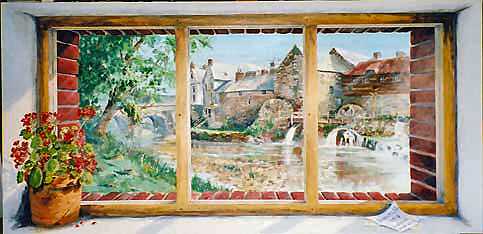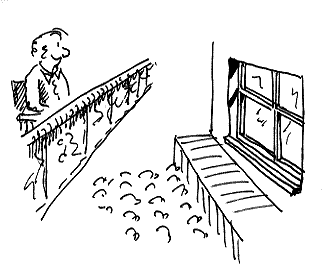SCENERY PAINTING
FOR THE AMATEUR MUSICAL THEATRE and PANTOMIME |
I was wondering if you could give me some ideas. I am working on a play and I have been assigned to paint fake books on a bookshelf and want to try and make them as realistic as possible. Also I have to paint a window prop and make it look you can see an outdoor scene. This window will be in an extremely upscale sanitarium. Thank you for your time.
Hello Mary,
Thanks for the email.
Your questions raise other questions from this end. The minute someone says they want to make stage scenery look as 'realistic as possible' there are two avenues/roads to go down.... One is to physically make the item. (Build a bookcase and fill with real books in your case) And the other route is to paint the item using perspective construction geometry. Not as terrifying as it sounds. In my (unpublished) book I have a chapter on perspective, so what I will do is upload a few of the pages onto this set-painting web site for you to have a look at. CLICK HERE to see it. (Close the separate window once finished with)
Lets talk first about the books. When painting books in a bookcase I always quickly run out of ideas! I run out of different colour ideas and how the back spines should differ from each other. So my advice is first to photograph rows of books in a library as a reminder when you are working. Have you thought of the imitation books one sees in furniture stores selling bookcases? They usually have cardboard (pasteboard) rows of imitation backs of books to make the piece of furniture look more appealing. Get the matt (non shiny) version though, as the stage lights will make them look too glossy.
Is the set a "box set" made of wood? A box set is a hollow square with the audience looking into the set from the empty side of the "box". If it is, you could staple these imitation card versions onto the flats. But if it is a canvas cloth you are painting on then you won't be able to use this card books idea and will have to paint the books directly onto the canvas.
Don't paint too much detail. Look at the books I painted for this "Oliver" scene. CLOSE THE SEPARATE WINDOW ONCE FINISHED WITH. It's a laborious job painting a row of backs of books and no doubt the front row of your audience will be quite a distance back so won't be able to see the titles in any case. I generally do a squiggle which from a distance could be the title etc. The only time I paint on the titles is when I put my name on the spines and that's for the cast to find when they are acting - always gives them a little smile when they suddenly discover it. Inevitably the void around the books in a bookcase is quite a dark colour - it's shaded within the shelves of a bookcase.
The window. Here are two problems. The scene through the window and the window frame itself.
What you paint as a scene outside of the wndow is up to you. But if you want to make it as realistic as possible then stick to the laws of perspective and have the eye line/horizon line the same level as your audience. The window frame and shape is also your decision too of course. Here I only advise on how to go about the painting.
Once I have drawn out the construction lines for both scene and frame on the flat (or canvas) I then lay masking tape along the frame lines. This means I can then paint away at the scene and not worry that I will obliterate where the frame has to go. Once my scene has been painted AND ALLOWED TO DRY I then "knock it back" which is an artist's term for making it less sharp and not in focus and dull the strong colours. I do this by using a very dry wide brush dipped in white paint. I do a couple of practice strokes on something unimportant (perhaps a flat waiting to be painted) which gets rid of a lot of the paint. I then scrub this white over the whole painting. First time you do this you will end up with too much white paint, so have some clean water nearby and some rags to quickly wash off the excess paint. You will find this gives a nice misty look to your picture. Once you are happy with your work, then let it dry. Now pull off the masking tape.to attack the frame.



You also have to take into account where the frame is on the stage. Flat along the back or on one side at an angle? Again perspective comes into this.
Note you can't see the left section of the frame on the left (it is hidden by the wall) and vice versa on the other side.
Did you see there was also a window in the Oliver set I mentioned ealier on in this letter? Did you see that I'd painted the left hand edge of the glazing bars as the window was slightly biased to the right of the stage.
Now one way to avoid geometry is to use your imagination. I know that sounds weird but sit in the empty theatre (Choose the best seat in the house) and imagine your frame on the stage. Can you "see" up under the top glazing bars? Can you "see" the window sill? Can you "see" the left side, or right side, of the glazing bars? And don't forget that a window frame is not just set flat into a wall, there is bound to be some thickness to that wall.
Hope the above is of use. Best of luck with the work and let me know how
you get on.
Regards
Brian